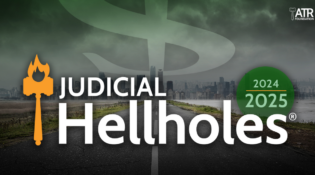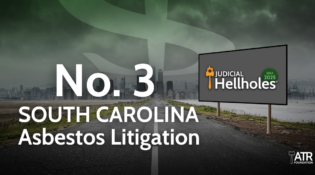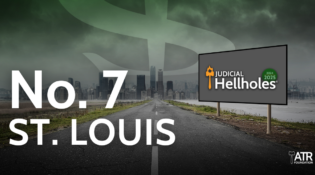DRIVERS OF THE MACHINE
Third Party Litigation Financing
 Third party litigation funding (TPLF) is the practice of investors buying an interest in the outcome of a law- suit. It has quickly become a multi-billion-dollar industry.
Third party litigation funding (TPLF) is the practice of investors buying an interest in the outcome of a law- suit. It has quickly become a multi-billion-dollar industry.
There are multiple types of litigation financing, but “big-ticket” lawsuit lending, typically involves hedge funds and private equity companies that specialize in financing mass tort litigation, commercial and intellectual property litigation, or a broader portfolio of cases handled by a law firm.
Third-party litigation funders front money to plaintiffs’ law firms in exchange for an agreed-upon cut of any settlement or money judgment. When these cases are resolved, the lawsuit lender is usually entitled to a percentage of the recovery, much like a contingency-fee. Investors are attracted by the prospect of a substantial return on their investment and law firms use the money to cover upfront litigation costs.
TPLF can create litigation, not just fund it. For example, an outsider’s financial investment in a case may be used to cover the cost of mass tort lawsuit advertising that has surged in recent years and the call centers that handle the responses. These ads often urge viewers who have taken a prescription drug, been treated with a medical device, or used a consumer product to “call right now” because “you may be entitled to substantial compensation.” Even when sound science does not support these suits, mass tort lawyers and their investors understand that if they quickly generate thousands of claims tying a widely used product to a common illness, the targeted company will face strong pressure to reach a global settlement. That settlement will result in a substantial payout to both the contingency-fee lawyers and investors.
TPLF raises a number of ethical concerns, such as a threat to a lawyer’s ability to exercise independent judgment in cases where the funder can influence litigation or settlement decisions. The presence of an unknown third-party with a stake in the outcome can change what is essentially a two-party negotiation into a multi-party process with a “behind-the-scenes” influencer. As a TPLF company executive has acknowledged, litigation funding “make[s] it harder and more expensive to settle cases.”
Trial Lawyer Advertising
Law firms and businesses known as “lead generators” spend obscene amounts of money on lawsuit advertising because they know it’s an effective way to needlessly scare consumers and encourage them to file claims.
These ads include those soliciting claims alleging that consumer products, pharmaceuticals, and medical devices were responsible for people developing medical conditions that either have a range of potential causes or the cause of which is unknown. Top targets of these ads include Roundup® weed killer, talcum powder and, more recently, the herbicide paraquat.
Roundup® has been the top target of mass tort product liability litigation TV ads since 2015, with an estimated $131 million spent on more than 625,000 ads airing nationally and locally across the country. Second only to Roundup® litigation ads, are ads soliciting claims alleging a link between the use of talcum powder and incidences of cancer. An estimated $109 million has been spent on more than 370,000 talc litigation ads nationwide since 2015.
Since plaintiffs’ lawyers have earned billions of dollars on talc and Roundup® litigation, showing a good return on their advertising investment, they’re now turning their attention to another herbicide–paraquat. Since the beginning of 2021, more TV ads have aired across the country soliciting claims alleging injuries caused by paraquat than mass tort ads related to any other product. Advertisers have spent more than $24 million to air more than 150,000 of these ads since 2021.
Junk Science
The trial bar engages in massive television ad buys and public relations campaigns that peddle misinformation and taint the public’s preconceptions, while judges in Judicial Hellholes® fail to restrict falsehoods in their courtrooms. For example, the trial bar is spending hundreds of millions of dollars trying to drive home the message that products like Roundup® and talcum powder cause cancer, despite the lack of sound scientific evidence verifying these claims.
Roundup®
Monsanto, the maker of Roundup®, is one of the country’s most vilified companies. Lawsuits have been filed in several Judicial Hellholes® including St. Louis, Philadelphia, and California. In October, Florida’s first trial began.
Monsanto faces thousands of cases across the country alleging Roundup® causes cancer. Expert wit- nesses testify that glyphosate, the active ingredient in Monsanto’s signature Roundup® weedkiller, is to blame for triggering the disease. Trial lawyers have chosen to file a bulk of the litigation in Judicial Hellholes® because judges are known to allow junk science in their courtrooms.
As detailed extensively in the St. Louis Judicial Hellholes® section, Monsanto recently prevailed in a jury trial in the 21st Judicial District of Missouri. The St. Louis case fell apart under cross-examination as the plaintiff’s expert witnesses proved less than credible. While the truth prevailed in this case, it is unreasonable to expect jurors to arrive at the proper resolution in the absence of judges performing their gatekeeping responsibilities and keeping junk science out of their courtroom.
Trial lawyers turn to individuals with dubious credentials and a loose appreciation of ethical norms for one reason – the truth simply isn’t on their side.
Environmental safety agencies in the U.S., Canada, Brazil, Australia, New Zealand, Japan, and the European Union have spent decades reviewing the health impacts of glyphosate. All agree that no credible evidence exists linking glyphosate to non-Hodgkin’s lymphoma.
But one outlier organization says otherwise. An advisory group of the International Agency for Research on Cancer (IARC) deemed glyphosate a “probable human carcinogen.” In 2017, a senior scientist on that IARC panel testified critical evidence favorable to glyphosate had been withheld and would likely have changed IARC’s conclusion. The panel, however, was run by Christopher Portier, a scientist who received $160,000 from litigators and worked under the direct supervision of a partner at one of the law firms suing Monsanto.
Talcum Powder
Plaintiffs’ lawyers see the media as co-counsel in mass tort litigation. Most recently, The New Yorker published a story about Johnson & Johnson and its long-running talc litigation. The company is attempting to resolve the talc-related claims against it through a bankruptcy process that Judge Michael Kaplan of the U.S. Bankruptcy Court called “the optimal venue for redressing the harms of both present and future talc claimants in this case – ensuring a meaningful, timely, and equitable recovery.” In February, Judge Kaplan ruled that Johnson & Johnson’s subsidiary acted in “good faith” when it commenced a bankruptcy case to achieve that laudable goal.
As Judge Kaplan’s ruling is reviewed by the U.S. Court of Appeals for the Third Circuit, the plaintiffs’ lawyers seems unwilling to let the case’s facts and legal arguments speak for themselves. Instead, as their communications with The New Yorker show, they helped orchestrate a media broadside in the form of a mis- leading 8,000-word article riddled with false statements, half-truths and omitted facts they then promoted tirelessly on social media. This pattern of lacing the record with inflammatory statements for the press and social media to amplify has real – and troubling – consequences, as evidenced by the violent threats leveled at Judge Kaplan and his staff on social media, voicemails, and emails since the plaintiffs’ attorneys ramped up their media campaign.
In advance of the hearing last February before Judge Kaplan on the issue now up on appeal, the plain- tiffs’ team funneled documents disclosed in the litigation to Reuters. Whether the intended result was to sway the scales of justice or smear Johnson & Johnson in the press to toy with its stock price, the fact is that plaintiffs’ attorneys use the media as their co-counsel.
Now, plaintiffs’ attorneys are at it again, persuading The New Yorker to print their allegations as if they were facts. One of the sources The New Yorker cites is the plaintiffs’ attorneys’ hired gun expert, Dr. David Egilman, who testifies that, every time he looks, he finds asbestos in the tissue of customers who use Johnson & Johnson’s Baby Powder. In addition, Dr. Egilman recently testified that, when shown a picture of the Orion constellation, it was a depiction of talc, which allegedly contained asbestos. To someone with a hammer, everything looks like a nail. What is also significant is that neither of these aspects of Dr. Eligman’s background were mentioned by The New Yorker.
The magazine also failed to disclose that, in 2007, Dr. Egilman conspired with others to violate a pro- tective order in a case regarding the drug Zyprexa, and he provided hundreds of cherry-picked confidential documents to various media outlets – including by using a sham subpoena. A federal district court held extensive hearings and strongly rebuked Dr. Egilman for his conduct, noting that he and his conspirators “executed the conspiracy using other people as their agents in crime.” Judge Jack Weinstein of the U.S. District Court for the Eastern District of New York stated that “Such unprincipled revelation of sealed documents seriously compromises the ability of litigants to speak and reveal information candidly to each other; these illegalities impede private and peaceful resolution of disputes.”
Judge Weinstein issued a Stipulated Order in which Dr. Egilman accepted responsibility and was ordered to pay Eli Lilly $100,000, which the company then donated to a charity of its choosing. Not surpris- ingly, none of this was reported by The New Yorker.
Despite a myriad of baseless claims by the plaintiffs’ bar, independent medical experts have not found a confirmed link between talcum powder and cancer.
Multi-District Litigation Abuse
The trial bar also seeks to exploit procedural advantages within the judicial system itself. Problems have centered on a little-known process known as multidistrict litigation – or MDL for short – used by the federal courts to consolidate lawsuits involving similar issues to save time.
After spending countless millions of dollars in advertising to recruit claimants, law firms flood the MDL process with tens of thousands of dubious claims, knowing that it’s next to impossible for judges – or the defendants – to sort through and check them all. These claims may include plaintiffs who did not even use the product at issue or whose medical condition likely had other causes.
It’s a big problem; over 70 percent of civil cases in federal courts are currently in MDLs. As of October 2022, there are nearly 400,000 pending cases in MDLs, largely in product liability litigation. This percentage has surged from under 30 percent just ten years ago. As two law professors noted in a recent article, “MDL’s gravitational pull over thousands of cases demolishes all of the normal expectations of individual process and federalism.”
Once thousands of cases are filed and consolidated, and without the protections that MDLs “demolish,” it’s often game over. It’s impossible to bring that many cases to trial, so MDL defendants are faced with two unappealing options: settle for a king’s ransom or declare bankruptcy.




 Third party litigation funding (TPLF) is the practice of investors buying an interest in the outcome of a law- suit. It has quickly become a multi-billion-dollar industry.
Third party litigation funding (TPLF) is the practice of investors buying an interest in the outcome of a law- suit. It has quickly become a multi-billion-dollar industry.

